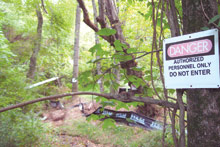Should warning signs be posted along West Asheville creeks and streams that may be contaminated by tetrachloroethylene, a chemical related to the one found at the CTS site in Skyland?

Hartwell Carson thinks so. Signs, the French Broad riverkeeper argues, were posted after an oil/fuel spill happened earlier this year at a Deaverview Road business. “There’s a process to notify people [when] there’s been such a spill [but] there’s nothing in place for this situation,” he says.
Tetrachloroethylene—also known as perchloroethylene, or PCE—was used at Andrex Industries, a textile and dry-cleaning company that once ran a facility at a 9-acre site on Deaverview. PCE can cause liver problems and may be a carcinogen, according to the U.S. Environmental Protection Agency. The chemical is a “colorless organic liquid with a mild, chloroform-like odor. Its greatest use is in the textile industry and as a component of aerosol dry-cleaning products,” according to EPA documents. (The contaminant at the CTS site is trichloroethylene. Both TCE and PCE can spread through surface- and ground-water sources. Both can degrade into the highly toxic vinyl chloride.)
Carson says he first learned about the West Asheville problem after receiving a 2007 stream-restoration grant from North Carolina’s Clean Water Management Trust Fund. A Malvern Hills resident brought the problem to his attention, showing him a map depicting the results of a 2008 evaluation of PCE levels within a mile of the old Andrex site, Carson explains. The map, dated February 2008, shows levels as high as 13 parts per billion at Smith Mill Creek and 6.9 ppb at Buttermilk Creek. The EPA’s allowable limit in public drinking-water sources is 5 ppb; the public must be notified if higher levels are recorded, according to an EPA consumer fact sheet.
The more disconcerting problem, Carson emphasizes, is that Smith Mill Creek runs through Roger Farmer Memorial Park, and Buttermilk is near Malvern Hills Park—both places where children play frequently. “It’s an unfortunate spot to have a spill [or] contamination, because the old Andrex site is on top of a small knoll with three creeks downhill from it,” notes Carson.
“There is ground-water contamination,” says Landon Davidson, aquifer-protection supervisor for the state Division of Water Quality. Cleanup efforts, he reports, began in 1991, when an Andrex employee poured about 100 gallons of PCE down a drain; the company was fined.
At the time, the spill prompted the evacuation of at least one West Asheville home, according to a Sept. 26, 1991, Asheville Citizen-Times report.
Subsequently, Andrex implemented cleanup procedures and monitored PCE levels in ground water. The company later sought and received permission from the city of Asheville to add monitoring wells at both parks, according to a Feb. 26, 1997, Citizen-Times article.
The company ceased operations in the late 1990s, however, and the property was listed under the state’s inactive hazardous-waste sites program. It’s unclear whether further cleanup occurred. But Milkco (an Ingles subsidiary that processes and packages dairy products) bought the property a few years ago. As part of the redevelopment process, the site was entered into the state’s Brownfields Program.
The program provides a process for redeveloping abandoned and often contaminated properties, Brownfields Project Manager Tracy Wahl explains. Milkco plans to expand its adjacent warehouse operation onto the Andrex property, she says. In the process, the first step is “making sure the site is safe” for the proposed use, Wahl continues. “Our intention was to remove the source [of the contamination]. That will have a positive impact on ground-water [quality] over time.” Milkco has undertaken that process, she adds. After removing as much contaminated soil as possible, the company will be responsible for monitoring PCE levels. If the contamination isn’t abated, further action may be required, she notes.
As for posting signs notifying people of contamination in nearby streams and soil, Wahl says, “It’s up to the property owner.”
A frustrated-sounding Carson says he’s been getting this same answer from every agency—state or local—he contacts about the problem. He’s also been told that a toxicology expert should be consulted concerning the potential danger posed by the PCE.
“Even if they are doing the right thing and there’s nothing further to be done from the cleanup side of it, people should at least know there’s a problem,” says Carson.
In the long run, he continues, removing as much of the contamination source as possible is the best approach. “But why not make sure we’re doing all we can?”
Send your environmental news to mvwilliams@mountainx.com.




Before you comment
The comments section is here to provide a platform for civil dialogue on the issues we face together as a local community. Xpress is committed to offering this platform for all voices, but when the tone of the discussion gets nasty or strays off topic, we believe many people choose not to participate. Xpress editors are determined to moderate comments to ensure a constructive interchange is maintained. All comments judged not to be in keeping with the spirit of civil discourse will be removed and repeat violators will be banned. See here for our terms of service. Thank you for being part of this effort to promote respectful discussion.